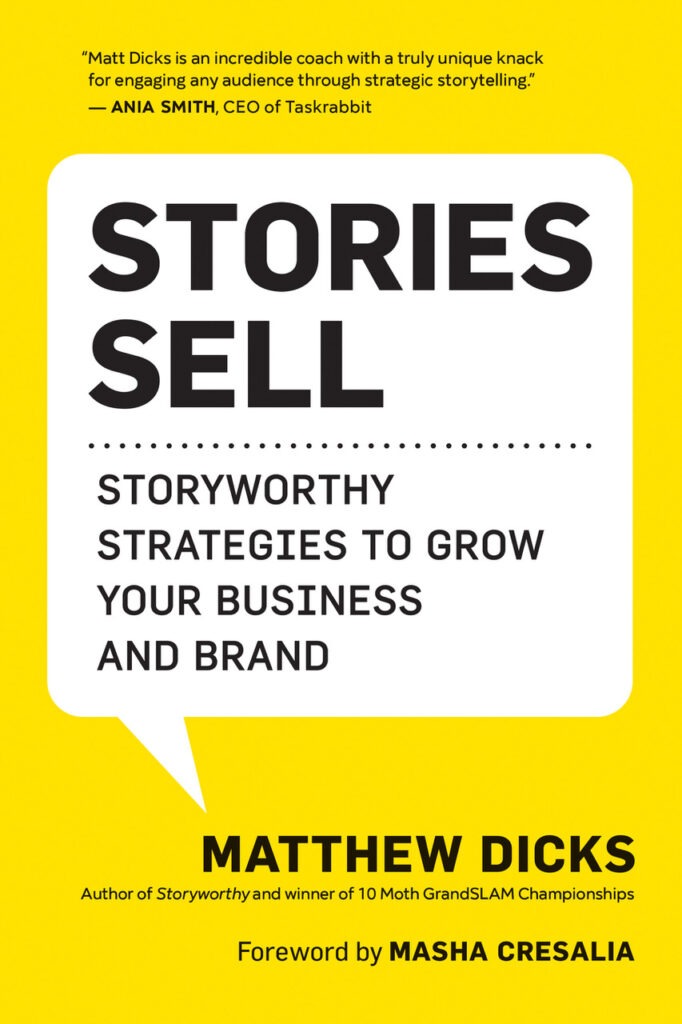Matthew Dicks is the author of Stories Sell and eight other books. A bestselling novelist, nationally recognized storyteller, and award-winning elementary schoolteacher, he teaches storytelling and communications at universities, corporate workplaces, and community organizations. Dicks has won multiple Moth GrandSLAM story competitions and, together with his wife, created the organization Speak Up to help others share their stories. They also cohost the Speak Up Storytelling podcast. He lives in Connecticut with his family.
- What initially drew you to the field of storytelling for business?
I met a man named Boris Levin – CEO of Mott Corporation – who convinced me that the storytelling I was doing to entertain audiences could also help him in business. I didn’t believe him at first, but after a meeting in a coffee shop, he convinced me that I could help. It began with Boris, then a local engineering firm, and then a local nonprofit, but within a year, I was working with Fortune 500 companies, Olympic athletes, tech startups, and more.
Business dragged me kicking and screaming into their world and convinced me that my understanding of storytelling could help sales, marketing, branding, leadership, entrepreneurs, public speakers, and more.
Thank goodness.
What are your top tips for crafting compelling stories that resonate with business audiences?
We must rightly assume that no one wants to hear anything we want to say, so we must be entertaining in all that we say and do. Storytelling can make this happen through elements like stakes, suspense, surprise, humor, vulnerability, and more.
There are many, many ways to entertain while delivering a message. Few people choose this path, so businesses and leaders who do can easily and effectively set themselves apart from the competition.
It’s the difference between reporting, listing, explaining, and describing…
… or telling a compelling narrative that makes an audience trust, believe, and love what is being said and who is saying it.
- How did you turn your storytelling career into a career in business?
I discovered, much to my surprise, that storytelling is storytelling is storytelling, meaning that the same strategies and techniques I use to entertain audiences from the stage and readers on the page are the same strategies that can be used to build a marketing campaign, design a pitch deck, write a commercial, develop a sales pitch, craft a keynote, revise a demo, and more.
There isn’t personal storytelling and business storytelling. It’s all just storytelling. I simply take what I have learned to do on the stage and page and bring it to the business world every day, and the results have been extraordinary.
- What separates you from others who attempt to bring storytelling to businesses and brands?
A few things:
- I do the job every day. I am a writer of novels and nonfiction, a storyteller, and a comedian who stands on stages constantly and entertains audiences. I write columns for magazines, plays, musicals, and even comic books. I write a popular blog and haven’t missed a day of publishing in 20 years. I do the job, and I continue to entertain audiences in theaters, art spaces, museums, bookstores, and on the pages of books and magazines and on the internet.
- I’ve also owned and operated my own businesses, so I understand the business world well. I built a wedding DJ company in 1997 that has become one of the most respected in the industry. I’ve built a storytelling business that sells asynchronous learning and workshops to people and companies around the globe. I’m currently a founding member of a tech startup. And for a dozen years, I managed McDonald’s restaurants throughout New England. I’m an investor in the stock market, following companies and sectors closely, and understand the business world. I do the job of building, managing, and running businesses every day. I understand and can relate to business people well.
- I’ve been a school teacher for more than 25 years. I understand how to break down large, complex, esoteric, and often incomprehensible topics into small, repeatable, understandable, and practicable components. I don’t just help businesses tell better stories. I teach business people to become better storytellers, and this only happens because I know how to teach. I have a quarter century of methodology, pedagogy, and instructional experience under my belt.
In summary, I’m a professional, nationally recognized, and award-winning storyteller and bestselling novelist who has also built and managed several businesses and is an award-winning teacher as well.
That combination is hard to find in today’s world.

- In your experience, what are the biggest challenges businesses face when trying to incorporate storytelling into their communications?
Storytelling demands that businesses do something different, and different is hard. It’s far easier to take the safe path, remain within the confines and comfort of the herd, and not take risks. Storytelling demands vulnerability. An attempt to be amusing, compelling, and personal.
Everyone desperately wants storytelling until they learn what storytelling is, then they are afraid.
What are some of the most common mistakes you see businesses make when using storytelling?
There is a fear that telling a story wastes time or will make the audience feel like time is being wasted. Business people are afraid to tell stories and entertain an audience because they fear that “entertaining” is unnecessary when, in fact, it’s everything.
People fear sharing personal or vulnerable details about themselves, their business, or their product when these details can have enormous impacts on perception, brand, and sales.
Businesses avoid humor, fearing it won’t make them sound serious when we know that humor alters brain chemistry in enormously powerful ways.
Businesses are overly invested in the “how” of their products but not the “what” and “why.” When Steve Jobs launched the first iPod, he described it as “1,000 songs in your pocket”. He did not explain to consumers how it worked because consumers almost never care about how it works or what effort and investment went into the design and manufacturing of the product. They want to know what it is and why they need it.
This can be done best via storytelling.
Most business communication today is round, white, and flavorless—totally forgettable. Being memorable and impactful requires daring, but daring is hard to find.
- How can storytelling be used to achieve specific business goals, such as increasing brand awareness, driving sales, or building customer loyalty?
Storytelling allows for indelible connections between business and customer, makes messaging memorable, and helps explain complex processes. Storytelling makes leaders more relatable, more understandable, and more impactful. Storytelling leverages the part of the human brain designed to process and retain stories. Storytelling can make a brand more sticky, a sales pitch more enticing, and a request for investment more compelling.
Steve Jobs said, “The most powerful person in the world is the storyteller.”
- You give several examples of companies using storytelling successfully. Can you share one that you find particularly impactful and explain why?
The way that Domino’s launched its campaign in 2009 – acknowledging that their pizza was bad, airing customers’ negative opinions of their product, and promising to do better – has always impressed me. They led with vulnerability and told the story of a company that decided to take bold action in the face of overwhelming evidence and a desire to be better. Analysts advised against it. Investors trembled at the thought of a pizza company admitting that their pizza tasted bad. But since 2009, Domino’s has outpaced the S&P and is the fastest growing pizza restaurant in the world. Many things went into their transformation, but it started with a story.
- If you have specific examples of stories that resonated with you or ones you found ineffective, can you share them?
The hero of my book is Boris Levin, and all of his stories are fantastic. He tells the story of taking his father – a man dealing with slow-growing cancer – on a trip to the Caribbean but failing to take note of small details like the schedule, his diet, liquid intake, and sleep into account.
As a result., his father has a medical emergency on the plane, and it is diverted to Miami,
The story ends on a happy note. His father is fine, and they still manage to squeeze in their vacation, but it’s a lesson to Boris:
Small details, ignored often and long enough, create enormous problems. When planning the trip, he failed to consider his father’s small but multitudinous needs, creating a much larger problem.
He sees the same thing happen in business:
Small problems, ignored for too long, can blossom into real disasters. He tells this story to his employees – a story filled with vulnerability, suspense, surprise, and even humor – and then pivots into the lesson he wants them to take away. It’s a brilliant way to be entertaining, memorable, and impactful.
Boris has a ton of stories like this. He’s brilliant.
- How do you use storytelling in your own professional life?
Constantly.
- I use stories to engage, entertain, and educate my students.
- I use storytelling to inform the parents of students about the performance of their students.
- I used storytelling almost exclusively to build my DJ business, and I continue to use it in building my current business and the startup I’m helping to launch.
- I use storytelling every time I speak in public – TEDx Talks, inspirational speeches, keynotes, lectures, book talks, and more.
- I relentlessly tell stories as part of my book marketing —on podcasts, appearances, and in written material.

Stories Sell: Storyworthy Strategies to Grow Your Business and Brand
By Matthew Dicks
Foreword by Masha Cresalia
Business / Personal Growth • $19.95
Trade paperback • 336 pp. • 6 x 9 • Pub date: June 11, 2024
ISBN: 978-1-60868-904-0
Also available as an ebook





